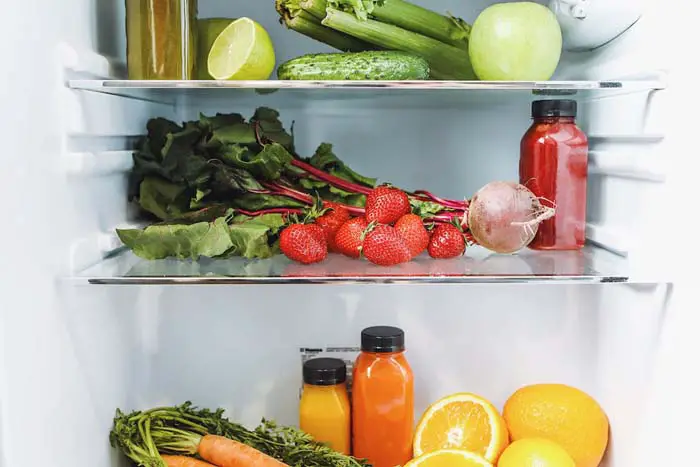Refrigerators may last a while but eventually break down due to everyday use. Even more crucial, a spotless fridge reduces spoilage. It sets the tone for the rest of the kitchen, which you want to be bright and inviting.
A lack of routine maintenance can lead to the accumulation of messy stains and food debris on the exterior doors, inside drawers, and shelves. In the meantime, overstayed food in the fridge might emit a foul odor whenever you open the door. This is not appealing to those nearby in the kitchen or the dining room. Additionally, it can be uncomfortable if you have guests. Plus, if you maintain your fridge neat, you can better use the space within.
Maintaining a spotless and fully functional fridge requires a monthly deep clean. It also needs shorter weekly tidies upon returning from grocery shopping. If you conduct a quick weekly clean, such as wiping down the condiments and counters with a damp towel and throwing out expired food to make room for the groceries you just bought, the monthly deep clean will be a breeze.
What are the benefits of keeping a clean refrigerator?
Cleaning the refrigerator is essential because it eliminates the ideal environment for the growth of bacteria. This can lead to illnesses like food poisoning. Most of us make weekly grocery runs even when we already have plenty of food in the refrigerator. This increases the likelihood of spoilage, which can lead to the spread of disease. When a curry or sauce splits after storing it for too long, bacteria might multiply. However, have no fear; we’ve thought of some good ways to clean a refrigerator.
Take everything out of the fridge and dispose of anything that has expired or gone rotten. Be sure to turn off the power to your fridge before you clean it. Continue reading!

How Often Should You Clean Your Fridge?
About once a month, you should empty your fridge. But you should do some tasks only once every few months.
Vacuuming the fridge coils
Turn off the power and carefully pull the fridge away from the wall. Use the brush attachment to vacuum the coils in the models in the back of the fridge. Coils can be hidden in the vents on the back, bottom, or top of some built-in and side-by-side models. Vents can be bolted into the top of the coils on some brands. A vacuum with a long, thin crevice tool is ideal for these models. For more information, check out the user guide. Reconnect the refrigerator and turn it on.
Inspect the drip pan:
A refrigerator’s condensation can be collected in a removable drip pan on some models. You will need a flashlight to find the drip pan once you have removed the grill from the bottom front of the refrigerator. Mold can grow over time in drip pans; therefore, it is important to protect your hands. The drip pan should be taken out and cleaned before being returned. You might have to sue bleach. If you’re not sure how to use anything, check the manual that came with it. Clean up the drip tray and front grill and replace them.
Tools and equipment
- Dishwashing gloves
- Non-abrasive plastic scrubber
- Soft, non-scratching rag
- Clean towels or cloths
Materials
- Vinegar or window cleaning
- Dish soap
- Trash bag
- Hot water
Instructions
Remove the Food
Getting your refrigerator completely empty is the first step in a thorough cleaning. When is it most convenient? You know it’s time to go grocery shopping when you run out of staples. Having fewer perishables in the fridge will make it simpler to empty it before cleaning. Until you are ready to return the food after cleaning, storing it in a refrigerator will ensure that it remains safe to eat. Toss out anything that has gone bad or is past its expiration date.
Remove shelves and drawers
Empty and remove all shelves and drawers. It would help to quickly clean plastic and metal cabinets in a sink full of hot water and dish soap. However, do not allow ceramic and glass containers to come to room temperature first.
Clean the inside of the refrigerator
Hot water and a little dish soap will do the trick on a clean cloth. It’s best to start at the top and work your way down. This is to avoid getting water in recently cleaned areas. Sticky spills may require a plastic, non-abrasive scrubber. But a warm, damp towel placed over the affected area for a few minutes can also do the trick. The spilled area will soften, making cleanup less of a chore.
To prevent germs from spreading, rinse the rags you use while cleaning or use several of them. When cleaning the refrigerator, focus on the cracks at the bottom and the back. This is because they are common paths for spills to take. Last but not least, clean the internal doors.
Clean drawers and shelves
Now that your drawers and shelves have warmed up, you should take this opportunity to give them a good scrub and dry them out. Glass shelves can be extremely dangerous because of their slick surface. You can avoid breakages by using dishwashing gloves.
Dry the interior of the fridge
Ensure the fridge’s inside is dry by wiping it off with a clean towel or cloth. The inner doors must also be dried.
Replace the food
Ensure that you return the food from the cooler to the fridge at this point. While you’re working on this, give some attention to how the condiments and food are going to be organized. Do you frequently go for the milk, only to discover that the fridge is too full? Are you storing meat, vegetables, and fruits in the same drawers, even though you should keep them apart? Put items back with care; you just spent time cleaning your fridge, so it needs to serve its purpose well.
Clean the outside
Wipe off the exterior of the fridge using warm water and mild dish soap, working your way down from the top. To maintain the luster of your stainless steel fridge, you can use vinegar or window cleaner with a soft, non-scratching towel. The rubber gasket seal around the door’s edges should also be cleaned with dish soap and warm water. When this area gets dirty, the seal can break.
How to Maintain a Clean Refrigerator
You can extend the time between thorough cleanings of your refrigerator by adhering to a few basic maintenance procedures.
· Step one: Keep perishables in their own storage
You should use all available resources to minimize or eliminate the possibility of food contamination. Maintain separate compartments in the refrigerator for raw meat and fish. This will help prevent juices from mixing. Similarly, separate foods that have not been cooked from those that have been.
· Step two: Check for mold
Mold may easily infest foods like bread. Don’t give mold a chance to take over the refrigerator. It could potentially contaminate other foods. To remove mold, you can use two tablespoons of vinegar and two tablespoons of baking soda in one cup of water. Use a spray sprayer to apply the mixture to the moldy areas. Use a worn-out toothbrush and water to scrub, followed by a sponge wipe-off. After you’re done cleaning, open the windows.
· Step three: Store food in the refrigerator
Put opened packages of spices and seasonings in the refrigerator as soon as possible after use. Don’t leave them outside for an extended period of time.
· Step four: Treat stains quickly
Immediately mop up any messes you may find, such as spills or drips. This will make trash pickup easy and help maintain a clean environment in your kitchen.
Conclusion
Maintaining a clean refrigerator consistently will reduce the frequency with which you need to perform a thorough cleaning. You can avoid having to undertake a thorough cleaning of the refrigerator by keeping it clean on a regular basis. Additionally, it is best to discard perishable food items before they go bad. The tips outlined here should be useful if a thorough cleaning is necessary. Please take whatever measures are necessary to ensure that your refrigerator remains a sanitary environment to store food for your loved ones.

